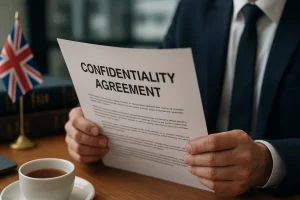Understanding the differences between a confidentiality agreement and a non-disclosure agreement (NDA) is essential for businesses operating in the UK.
While these terms are often used interchangeably, they serve distinct purposes in protecting sensitive information.
Whether entering into employment contracts, business negotiations, or strategic partnerships, having the right legal agreement in place helps safeguard intellectual property and maintain competitive advantage.
This guide explains what each agreement entails, when to use them, and how they differ in scope and application.
What Is A Confidentiality Agreement And Why Is It Important For UK Businesses?

A confidentiality agreement is a legal contract that outlines the terms under which information shared between parties must be kept private. It plays a significant role in various UK business transactions, including mergers, employment, product development, and investor discussions.
There are two primary types of confidentiality agreements:
- Unilateral: Where only one party discloses confidential information.
- Mutual: Where both parties agree to exchange and protect sensitive data.
These agreements are crucial for businesses that handle intellectual property, client data, trade secrets, or other proprietary material. They provide a framework for legal recourse in the event of a breach, and they establish boundaries on how information can be used or shared.
Confidentiality agreements are often included as standalone contracts or integrated into larger commercial agreements. UK businesses use them to mitigate risk, protect assets, and support long-term strategic goals.
How Does A Non-Disclosure Agreement (NDA) Function In A Business Setting?
A non-disclosure agreement (NDA) functions by establishing the terms under which specific information cannot be disclosed to third parties. In a business context, it ensures that sensitive material such as financials, operations, product concepts, or client data is handled securely and responsibly.
Key components of an NDA typically include:
- The parties involved
- Definition of confidential information
- Duration of the confidentiality obligation
- Permitted disclosures or exceptions
- Consequences of breach
NDAs are frequently used in business transactions such as:
- Potential partnerships and acquisitions
- Client and vendor onboarding
- Recruitment of executives or specialists
- Collaboration with external consultants or advisors
Below is a table summarising the different types of NDAs and their use cases:
| NDA Type | Description | Common Use Cases |
|---|---|---|
| Unilateral NDA | One party discloses information to another | Hiring, contractor onboarding |
| Mutual NDA | Both parties exchange confidential information | Joint ventures, business partnerships |
| Multilateral NDA | Three or more parties involved in the information exchange | Large consortium projects or corporate deals |
Using an NDA provides a layer of legal security for businesses that wish to explore opportunities without risking exposure of their competitive intelligence.
What Are The Key Differences Between A Confidentiality Agreement And A Non-Disclosure Agreement?

While both confidentiality agreements and non-disclosure agreements (NDAs) are designed to protect sensitive information, their differences often emerge in terminology, context, purpose, and legal application.
In the UK, these terms are often used interchangeably, but certain distinctions can influence how they are drafted, implemented, and enforced.
1. Terminology and Common Usage
The primary distinction lies in the terminology and industry preference. A confidentiality agreement is typically viewed as a broader, more formal legal document, while a non-disclosure agreement is considered a more specific tool used to prevent information sharing in defined circumstances.
- Confidentiality Agreement: Commonly used within employment contracts, partnership agreements, and professional relationships where ongoing confidentiality is expected.
- Non-Disclosure Agreement: Frequently used in short-term commercial dealings, such as investor discussions, product demonstrations, or vendor negotiations.
In practice, UK businesses often use confidentiality agreement in long-term or internal contexts, and NDA in temporary or transactional settings.
2. Scope and Coverage
A confidentiality agreement usually encompasses a wider range of obligations than an NDA. It may include not only non-disclosure but also non-use, data protection, intellectual property protection, and ethical conduct clauses.
An NDA, on the other hand, tends to focus strictly on restricting disclosure of specific information related to a project or negotiation.
For instance:
- A law firm might use a confidentiality agreement to protect all client information shared across multiple cases.
- A tech startup might sign an NDA with a software developer to prevent them from revealing prototype details to competitors.
3. Duration and Enforceability
Both agreements must specify how long the confidentiality obligation lasts, but confidentiality agreements typically have longer or indefinite terms, particularly in industries where trade secrets or client data are involved.
NDAs, however, often have a fixed duration, for example, 12 or 24 months which covering the period during which discussions or collaborations occur.
Courts in the UK tend to uphold reasonable timeframes, but overly long or restrictive clauses may be deemed unenforceable.
4. Legal Framework and Documentation
While both documents are legally binding under UK contract law, a confidentiality agreement is often more detailed and comprehensive, including references to:
- The purpose of the disclosure
- Ownership of information
- Return or destruction of documents after use
- Remedies for breach of confidentiality
An NDA, conversely, may be shorter and more straightforward, focusing solely on what information must not be shared and the consequences if it is.
This distinction makes NDAs suitable for preliminary discussions, while confidentiality agreements are preferred for ongoing partnerships or employment arrangements.
5. Mutuality and Party Involvement
Confidentiality agreements are more likely to be mutual, as both parties in a business relationship may exchange sensitive data. NDAs, however, can be unilateral or mutual, depending on the situation.
For example:
- Unilateral NDA: When a company discloses product designs to a manufacturer.
- Mutual NDA: When two companies collaborate on a joint research project.
The degree of mutuality determines how each party’s responsibilities are structured and enforced.
6. Practical Use Cases
Understanding when to use each document is crucial for proper risk management. The table below highlights the most common business scenarios and the agreement type typically used.
| Use Case | Recommended Agreement Type | Description and Purpose |
|---|---|---|
| Employment or partnership relationships | Confidentiality Agreement | Protects long-term access to company data and trade secrets. |
| Business negotiations or proposals | Non-Disclosure Agreement (NDA) | Limits information sharing during talks or preliminary deals. |
| Intellectual property or product designs | NDA or Confidentiality Agreement | Depends on whether disclosure is ongoing or limited to one-time access. |
| Legal or medical services | Confidentiality Agreement | Ensures compliance with professional confidentiality obligations. |
| Vendor or subcontractor relationships | NDA | Restricts disclosure of operational or technical project details. |
7. Formality and Tone
A confidentiality agreement is often drafted in formal, legal language, suitable for regulatory or employment settings. It may include references to data protection laws, professional ethics, and corporate policies.
An NDA, by contrast, is generally simpler and more commercial in tone, focusing purely on non-disclosure obligations. This makes it more accessible and quicker to execute in fast-paced business environments, such as mergers, pitches, or supplier negotiations.
8. Level of Customisation
Confidentiality agreements tend to be customised for a specific company or professional setting, reflecting the internal policies and industry standards.
NDAs are often template-based, particularly when used repeatedly in similar contexts, like investor meetings or product launches.
However, both should be reviewed carefully to ensure that key terms such as what counts as confidential information, how it is handled, and who can access it are appropriate for the situation.
9. Summary of Key Legal and Practical Differences
| Factor | Confidentiality Agreement | Non-Disclosure Agreement (NDA) |
|---|---|---|
| Primary Purpose | Broader, covering multiple confidentiality aspects | Focused mainly on restricting disclosure |
| Typical Duration | Long-term or indefinite | Fixed, usually 1–3 years |
| Formality | Detailed and formal | Shorter and more practical |
| Usage Context | Employment, partnerships, regulated sectors | Negotiations, vendor or investor meetings |
| Legal Complexity | Higher, often integrated with other agreements | Moderate, standalone document |
| Mutual vs Unilateral | Usually mutual | Often unilateral, but can be mutual |
| Level of Detail | High—may include usage, ownership, and remedies | Moderate—focused on disclosure only |
| Preferred By | Established organisations and professional firms | Startups, SMEs, and project-based businesses |
10. Choosing The Right Agreement
When deciding whether to use a confidentiality agreement or an NDA, the choice depends on:
- Nature of the information: If the data involves trade secrets, customer lists, or financial records, a comprehensive confidentiality agreement is appropriate.
- Duration of the relationship: For short-term discussions, a concise NDA may suffice.
- Industry regulations: Sectors like healthcare, finance, and law often require detailed confidentiality agreements due to statutory obligations.
- Reciprocal exchange of data: Mutual NDAs or confidentiality agreements are suitable when both parties disclose information.
Selecting the right document ensures that all parties are protected without overcomplicating the contractual process. Both agreements remain valuable tools for maintaining trust and compliance in the UK business environment.
Who Needs To Use Confidentiality Agreements Or NDAs In The UK?
Confidentiality agreements and NDAs are essential tools for various professionals and organisations across the UK. These legal documents help prevent the unauthorised use or disclosure of key business information in several situations.
They are commonly used by:
- Startups and entrepreneurs when sharing new ideas with investors, partners, or co-founders
- SMEs that engage contractors, vendors, or technology partners
- Large corporations during acquisitions, audits, or internal restructures
- Consultants and freelancers who require access to confidential project information
- Employees who handle sensitive internal data as part of their role
In many cases, NDAs are presented before entering negotiations or commencing work. They signal professionalism, protect valuable information, and clarify each party’s responsibilities.
What Legal Considerations Should You Be Aware Of Before Signing An NDA Or Confidentiality Agreement?

Before entering into a confidentiality agreement or NDA in the UK, it is important to consider the legal framework and ensure the document is enforceable. A poorly drafted agreement could be challenged in court or dismissed altogether.
Key legal considerations include:
- Clarity of terms: The definition of “confidential information” must be clear and specific. Vague or overly inclusive language may cause confusion.
- Reasonableness: Courts are more likely to enforce agreements that are reasonable in scope, geography, and duration.
- Remedies for breach: The agreement should outline legal options such as damages or injunctive relief.
- Inclusion of governing law and jurisdiction: It must state that UK law applies and which court has jurisdiction in the event of a dispute.
- Exceptions to confidentiality: For example, information that becomes public knowledge or is independently developed should be excluded.
It is advisable to have these documents reviewed by a solicitor, especially when dealing with high-value assets or sensitive operational details.
How Can Businesses Ensure Confidentiality Agreements And NDAs Are Enforceable?
To ensure enforceability, businesses must carefully draft confidentiality agreements and NDAs that reflect the realities of their relationships and operations. Courts in the UK may decline to enforce overly broad or unfair terms.
Effective agreements typically include:
- A well-defined scope of confidential information
- Specific purposes for which the information can be used
- A defined duration of the obligation, typically ranging from 1 to 5 years
- Limitations on disclosure to third parties or affiliates
- Explicit clauses about legal remedies in the event of a breach
Some tips for businesses include:
- Use templates as a base, but tailor them to the specific relationship or project
- Make sure the document is signed before any information is shared
- Revisit agreements during contract renewals or major project changes
Using a table, here are best practices compared to common pitfalls:
| Best Practices | Common Pitfalls |
|---|---|
| Clear definitions and scope | Vague terms and unclear boundaries |
| Reasonable limitations in time and scope | Overly restrictive clauses |
| Proper legal review and updates | Use of outdated or copied templates |
| Signed by all relevant parties | Verbal agreements without documentation |
Creating clear and reasonable expectations within the agreement increases the likelihood that it will be respected and legally enforced if needed.
What Are Common Mistakes To Avoid With Confidentiality Agreements And NDAs?
Many UK businesses, particularly startups and small enterprises, make avoidable mistakes that can compromise the effectiveness of their confidentiality agreements and NDAs.
Some of the most frequent errors include:
- Failing to define confidential information clearly: This leaves room for interpretation and can weaken the agreement.
- Using boilerplate templates without customisation: Generic terms may not suit the specific relationship or industry.
- Not specifying the duration of confidentiality: Without clear timeframes, obligations can be disputed.
- Omitting dispute resolution mechanisms: Lack of clarity about how breaches will be handled can result in delayed or ineffective enforcement.
- Overly broad obligations: If the restrictions are too expansive, courts may rule them unenforceable.
To avoid these pitfalls, businesses should draft tailored documents with the help of legal professionals and regularly review them to ensure they remain relevant.
How Do NDAs Compare To Non-Compete And Non-Solicitation Clauses?
NDAs, non-compete, and non-solicitation clauses are all tools used to protect a business’s interests, but they serve different purposes and have different legal implications in the UK.
NDAs focus on keeping information private, while non-compete clauses prevent someone from working for a competitor after leaving a business. Non-solicitation clauses restrict individuals from poaching clients or employees.
| Clause Type | Main Purpose | Legal Standing in the UK |
|---|---|---|
| Non-Disclosure Agreement | Prevent sharing of confidential data | Generally enforceable with clear terms |
| Non-Compete Clause | Stop employees from joining competitors | Strictly limited and often difficult to enforce |
| Non-Solicitation Clause | Prevent poaching of clients or staff | More acceptable if reasonably drafted |
Employers must ensure that these clauses are narrowly tailored and necessary to protect legitimate business interests. Overly restrictive clauses are likely to be deemed unenforceable in UK courts.
When Should You Update Or Revisit A Confidentiality Agreement Or NDA?

Businesses should not treat confidentiality agreements and NDAs as one-time documents. Regular reviews and updates are important to ensure they remain accurate, relevant, and legally valid.
You should consider updating your agreements when:
- The scope of work changes or new services are added
- New parties join a project or partnership
- There are legal or regulatory changes, such as updates to data protection laws
- The original agreement has expired or the confidentiality period has lapsed
- There is a significant internal restructure or business model change
Periodic reviews help ensure that all parties remain aligned and that the agreement continues to meet its intended purpose.
Conclusion
Confidentiality agreements and non-disclosure agreements are critical legal instruments that enable businesses to operate securely and confidently.
They not only protect valuable information but also foster trust between parties, whether in employment, partnerships, or negotiations.
By understanding the differences, applications, and legal considerations, UK businesses can better protect themselves from reputational and financial risks.
With proper drafting, enforcement, and periodic reviews, these agreements become foundational tools for sustainable and secure business growth.
FAQs
Are NDAs legally binding in the UK?
Yes, NDAs are legally binding if they meet the standard requirements of a valid contract, such as clear terms, mutual consent, and lawful purpose.
Can a confidentiality agreement be oral in the UK?
While oral agreements can be enforceable, written agreements are strongly preferred as they provide clarity and evidence in case of a dispute.
What happens if someone breaks an NDA or confidentiality agreement?
The injured party may seek legal remedies, including injunctions to prevent further disclosure and compensation for any damages incurred.
Do freelancers and consultants need NDAs?
Yes, NDAs are essential for protecting business ideas and client data shared with freelancers or consultants during projects.
How long does a confidentiality agreement last?
The duration is typically defined in the agreement. It can range from a few months to several years depending on the nature of the information.
What’s the difference between a mutual NDA and a unilateral NDA?
A mutual NDA involves both parties sharing confidential information, whereas a unilateral NDA involves only one party disclosing confidential information.
Is a non-disclosure agreement the same as a confidentiality clause in an employment contract?
No. While similar, a confidentiality clause is part of a broader contract, whereas an NDA is usually a standalone agreement focused entirely on protecting sensitive data.







